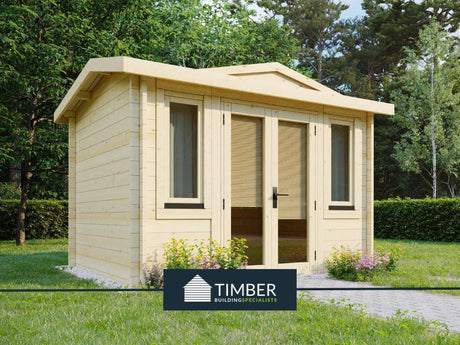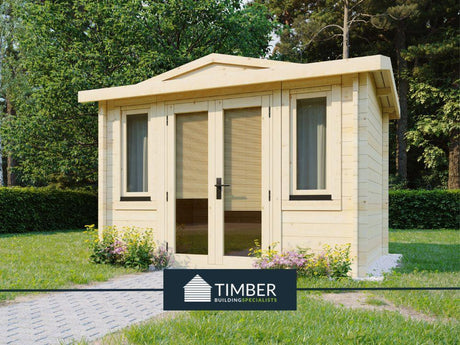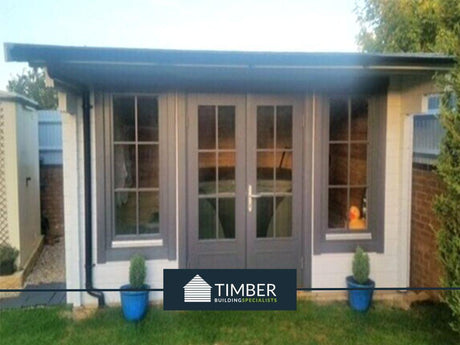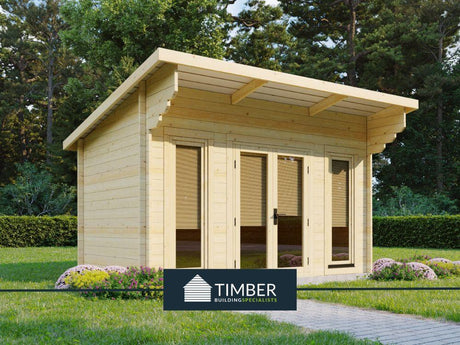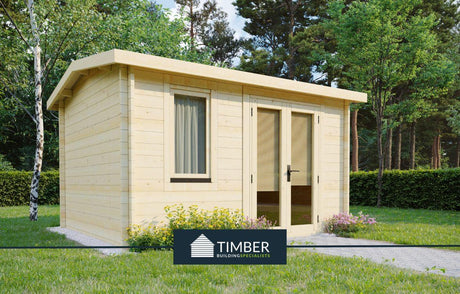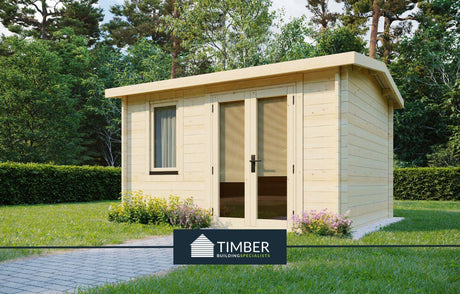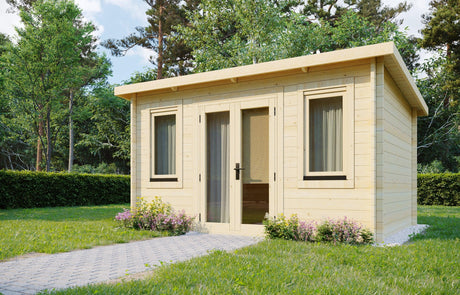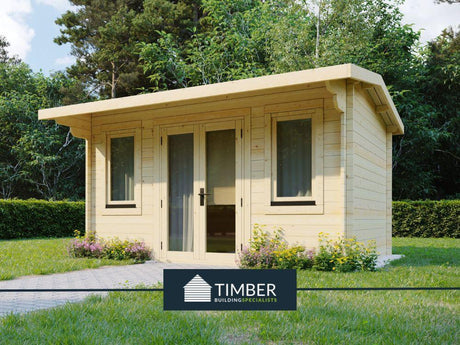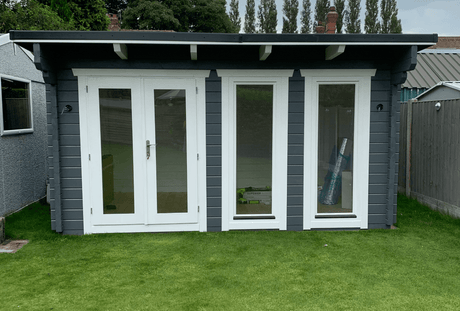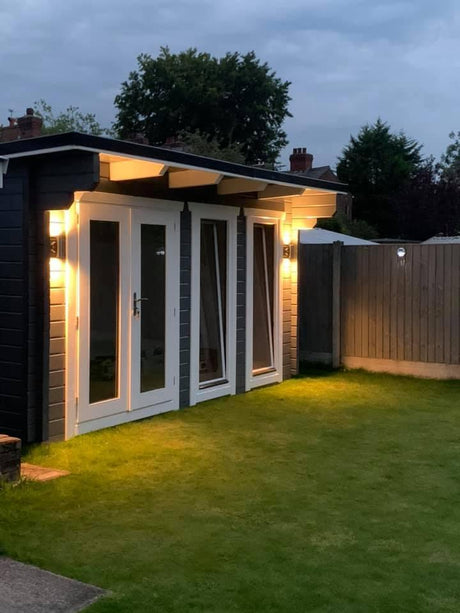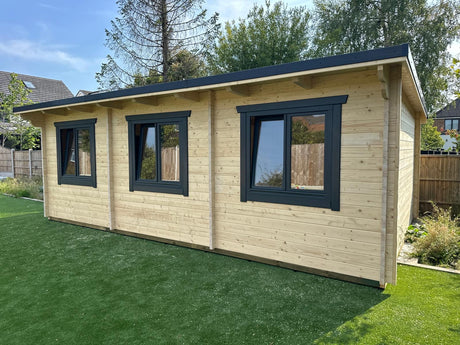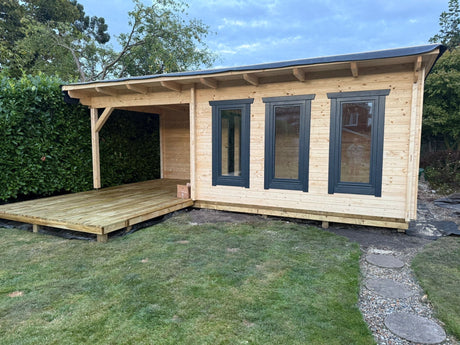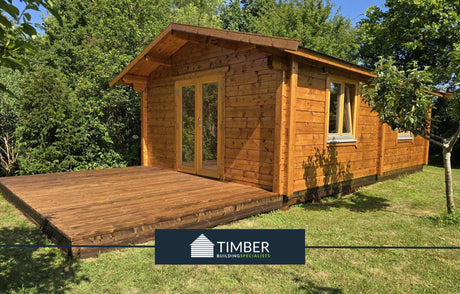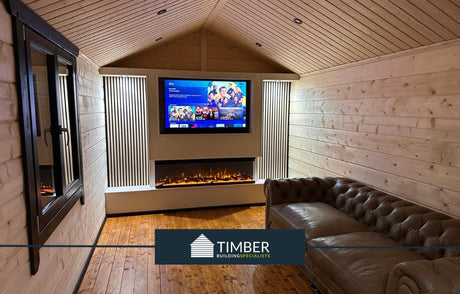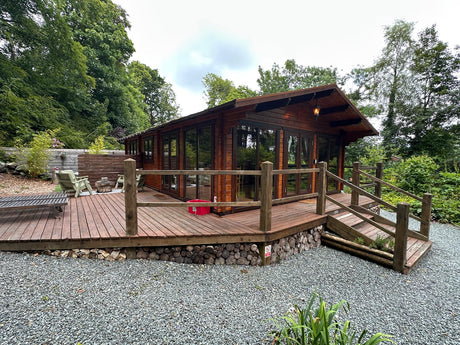Size flexibility in log cabin design means you can tailor your living space to exactly what you need. You're not stuck with standard layouts or sizes. Instead, plan a cabin that evolves with your lifestyle, offers room for hobbies, and grows with your family. Incorporate smart design choices and multifunctional furniture to optimise small spaces. Plus, thinking ahead about future modifications can save you money down the line. By matching your lifestyle and future plans to the cabin size, you create a space that truly feels like home. Discover how the right planning and customisation can transform your log cabin dream into reality.

Understanding Size Flexibility
Size flexibility in log cabin design offers you the freedom to tailor your living space to your specific needs and desires. This instance of size flexibility means you're not boxed into standard dimensions or layouts. Instead, you can apply your vision to create a space that truly feels like home. Whether you're dreaming of a cozy studio nestled in the woods or a sprawling family retreat, size flexibility ensures your log cabin can evolve with your lifestyle.
But how do you make the most of this flexibility? First, consider how you'll use the space, both now and in the future. This foresight allows you to reserve areas for expansion or modification without undergoing a complete overhaul. Additionally, embracing size flexibility can lead to cost savings. By only building what you need, you can apply your budget more efficiently and may even qualify for a discount on materials or services.
In essence, size flexibility in log cabin design isn't just about the physical space—it's about creating a personalised haven that adapts to your life. With the right approach, you can make your log cabin dream a reality, tailored precisely to your requirements.

Assessing Your Space Needs
Before diving into the design of your log cabin, it's crucial to carefully evaluate how much space you'll actually need. This step is akin to determining the right instance size for your needs; it's about finding the sweet spot between having enough room and optimising for efficiency and cost.
When assessing your space needs, consider:
-
Current Lifestyle: Just as you'd choose log cabin based on the workload it needs to handle, think about your daily activities. Do you entertain often? Need a home office?
-
Future Plans: Reserve capacity for your future needs. Planning for a family, hobbies, or even a home business can influence your size requirements.
-
Outdoor Living Space: Like adding extra storage to log cabin for peak times, incorporating outdoor living areas can provide flexible space when you need it, without permanently increasing the size of your cabin.
-
Storage Needs: Evaluate your storage requirements carefully. Overestimating can lead to wasted space, similar to over provisioning resources.
This scenario of matching your lifestyle and future plans to the size of your log cabin emphasises the importance of size flexibility. By thinking ahead, you can ensure your cabin is a perfect fit for years to come.
The Planning Process
Once you've assessed your space needs, it's time to dive into the planning process of your log cabin design. This stage is where the concept of size flexibility truly shines, ensuring that your cabin not only meets your current requirements but can also adapt to future changes.
To optimise for instance size flexibility, you'll need to understand how size flexibility works. It's akin to being part of a size flexibility group, where designs aren't rigid but adaptable. Imagine you're planning for a cabin that needs to accommodate varying numbers of guests. Here, size flexibility allows you to create spaces that can easily be expanded or modified without significant rebuilds.
Consider the option to buy a reservation for additional space or features that you might need in the future. This way, you're not paying for extra space you don't currently need, but you have the option to expand when necessary. Plus, a reservation discount can apply, making future modifications more cost-effective.

Customising Floor Plans
Customising your log cabin's floor plan allows you to tailor each space to your specific needs and lifestyle preferences. Whether you're dreaming of a cosy retreat or envisioning a spacious family home, the flexibility of customising floor plans means you can modify your cabin to fit any different instance of life. From adding extra bedrooms for a growing family to carving out a quiet workspace, the options are virtually limitless.
Here are a few ways you can transform your space:
-
Expand your living area - Increase your communal space by opting for a new instance size in your living room or kitchen, perfect for those who love to entertain.
-
Create dedicated rooms - Modify the floor plan to include specific rooms like a home office, gym, or craft room, ensuring every different instance of your daily routine has its place.
-
Enhance outdoor living - Incorporate decks or patios into your floor plan, seamlessly blending indoor and outdoor living spaces.
-
Adapt for accessibility - Adjust instance sizes and layouts to accommodate mobility needs, ensuring your cabin is comfortable and accessible for everyone.
Maximising Small Spaces
Making the most of small spaces requires smart design choices that maximise functionality without sacrificing style. In the context of log cabin design, this principle is especially crucial. For instance, size flexibility with reserved areas or multi-functional furniture can significantly enhance the usability of limited spaces. Imagine a dining table that folds away or a bed that converts into a workspace during the day. These solutions not only optimise the available area but also ensure that every inch serves a purpose.
Moreover, the concept of capacity reservation plays a vital role in the optimisation process. By planning for spaces that can adapt to different needs, you're essentially future-proofing your cabin. This might mean installing built-in storage in unexpected places or choosing appliances that are both compact and efficient. The goal is to maximise the utility of each square foot, ensuring that no corner is wasted.
Through thoughtful design and strategic planning, you can transform a small log cabin into a cosy, functional home. Remember, it's not just about making do with less space—it's about creating an environment that feels both spacious and inviting, no matter its actual size.
Designing for Expansion
After exploring how to maximise small spaces, it's important to consider how your log cabin can grow with your needs through strategic design for expansion. Designing for expansion ensures that size flexibility only applies not just at the outset but as your life evolves. This means thinking ahead and choosing to optimise, for instance, the layout and structural elements in a way that accommodates future growth without the need for a complete overhaul.
Here are four key strategies to consider:
-
Modular Design: Plan your cabin with modular sections that can be easily added. This approach allows for the instance size of your living space to increase as needed.
-
Flexible Interior Walls: Incorporate movable or non-load-bearing walls to easily reconfigure spaces without affecting the structural integrity of your cabin.
-
Expandable Utilities: Ensure that your plumbing and electrical systems have the capacity or reservation for a vm size increase, making expansions less complicated.
-
Foundation Preparation: Design the foundation to support additional weight and space, considering potential future expansions from the start.
Innovative Storage Solutions
As your log cabin evolves, integrating innovative storage solutions can significantly enhance your living space's functionality and efficiency. Think of each storage solution as an instance type in your cabin's architecture. Just like selecting the right instance type for a vm instance can optimise performance in computing, choosing the right storage solution can optimise your living space.
For instance, consider the size within your cabin. Compact, multi-purpose furniture that doubles as storage can be a game-changer, much like choosing the right instance family for computing needs can streamline operations. Utilise under-stair drawers or a bed with built-in storage to maximise the use of every square foot.
Next, think about the normalisation factor. In computing, this refers to adjusting resources to optimise efficiency. In your cabin, it means adapting your storage strategies to the available space. Use vertical space with wall-mounted shelves and hanging storage to keep the floor area clear and the room feeling open.
Incorporating Multi-Functional Rooms
Building on the foundation of innovative storage solutions, incorporating multi-functional rooms in a log cabin can further enhance your log cabin's efficiency and adaptability. Just as you'd manage resources in a cloud environment, think of your cabin as needing a reserved instance for various activities - a place where azure skies and lush surroundings inspire a multi-purpose approach to living.
Imagine your cabin's rooms as versatile as a compute reservation in AWS or Azure, where each space serves more than its primary function:
-
The Living Room: By day, it's a cozy lounge with a scenic view; by night, it transforms into a guest room, complete with a hidden Murphy bed.
-
The Kitchen: Not just for cooking, but also a hub for small gatherings or a makeshift office space, embodying the efficiency of a reserved instance where resources are optimised.
-
The Loft: An airy retreat that doubles as a creative studio or a quiet reading nook, maximising the utility of each square foot akin to cloud compute reservation strategies.
-
The Deck: While primarily an outdoor space, it can be enclosed and integrated with indoor heating to serve as a year-round greenhouse or dining area, stretching the boundaries of traditional room usage.
Incorporating multi-functional rooms into your log cabin design mirrors the flexibility and adaptability of managing cloud resources, where every inch of space, like every reserved instance, is meticulously planned to deliver maximum value.

Utilising Outdoor Areas
Maximise your log cabin's living space by creatively utilising outdoor areas for both relaxation and functional purposes. Think of your outdoor space as the default extension of your indoor living area. With a bit of imagination and strategic design, you can transform any exterior space into a versatile, inviting zone.
Consider the concept of normalisation in your design approach. Just as you prioritise different zones within your home for specific activities, apply the same principle outdoors. Designate areas for dining, lounging, or even a workspace, ensuring each has its own unique feel yet seamlessly integrates with the natural surroundings.
The availability zone of your outdoor space is crucial. You'll want to assess the sun's path, wind patterns, and natural shading to determine the best locations for various activities. This understanding will guide you in creating comfortable, usable spaces throughout the year.
Give priority to creating multi-use spaces that can adapt to your changing needs. A dining area can double as a workspace during the day, while a cozy fire pit area can serve as a gathering spot for evening relaxation.
Embrace the concept of tenancy in your outdoor design. Just as you'd personalise indoor spaces, infuse your outdoor areas with elements that reflect your style and interests, making them true extensions of your home.
Choosing the Right Materials
Selecting the ideal materials for your log cabin is crucial for ensuring durability, aesthetic appeal, and environmental harmony. Just like choosing the right linux distribution for your server needs, selecting materials for your cabin requires careful consideration of your specific requirements and the environment it will inhabit.
When planning your log cabin, envision the materials as components in a finely tuned system, akin to selecting an azure reserved instance running your critical applications. Each part plays a role in the structure's overall performance and sustainability. Consider the following:
-
Wood Type: Just as you'd select a specific VM for its performance characteristics in a specific availability zone, choose wood that not only fits the aesthetic but also thrives in your cabin's climate.
-
Insulation: Essential for maintaining temperature, much like optimising your server's resources for efficiency.
-
Roofing Material: Select materials that stand up to your local weather patterns, ensuring your cabin remains a sanctuary through all seasons.
-
Windows and Doors: High-quality windows and doors are the interface between your cabin's interior and the external environment, akin to the essential firewall protecting your VMs from external threats.
Energy Efficiency and Size
When designing your log cabin, considering the size is crucial for energy efficiency, much like optimising a database for faster queries. The relationship between energy efficiency and size can't be overstated. A compact design means less space to heat or cool, leading to significant savings on your energy bills. It's about finding the sweet spot where your cabin's capacity meets your priority needs without excess space that drains resources.
Optimising the size of your log cabin isn't just about minimising its footprint. It's also about smart design choices that enhance its energy efficiency. Proper insulation, strategic window placement, and considering the cabin's orientation can maximise natural light and heat, further reducing your energy needs. These decisions upfront can affect the pricing of your build but consider them investments in long-term savings.
Budgeting for Flexibility
How can you ensure your log cabin design remains within budget while still allowing for size flexibility? It's a balance of smart planning and prioritizing your needs. Here's how you can achieve it:
-
Define Your Must-Haves: Before diving into the design, list out the non-negotiable features your log cabin must have. This could range from the number of bedrooms to essential living spaces. Knowing your essentials helps prevent overspending on less important aspects.
-
Research Cost-Effective Materials: Look for building materials that offer both quality and value. Sometimes, opting for slightly higher-priced materials upfront can save money in the long run due to lower maintenance costs.
-
Plan for Phases: If your budget is tight, consider constructing your log cabin in phases. Start with the most critical parts of the home and gradually expand as funds become available. This approach keeps you within budget without sacrificing your vision for size flexibility.
-
Seek Professional Guidance: Hiring an experienced architect or designer who specialises in log cabins can offer insights into saving costs without compromising on your size flexibility needs. They can suggest design tricks and materials that align with your budget.
Navigating Building Regulations
Understanding building regulations is crucial to ensure your log cabin project doesn't face unexpected hurdles. Just like when you buy a reserved instance for cloud computing to save money, navigating these rules can offer financial benefits. Different areas come with their own set of codes, much like regional reserved instances in the tech world, which are tailored to specific locations.
Before you lay the first log, delve into the local building laws. Think of this research as similar to purchasing a reserved instance; you're investing upfront to ensure a smoother and more cost-efficient build. Each area has standard reserved instances, or in this case, standard building codes that apply to most structures, including log cabins. These cover everything from structural integrity to safety measures.
Securing a reserved instance discount is akin to finding loopholes or incentives in building regulations that could save you money. Perhaps there's a tax incentive for using certain materials or designs that are more energy-efficient.
The Role of Technology
In the world of log cabin design, technology plays a crucial role in streamlining the building process and enhancing design capabilities. It's about more than just the aesthetics; it's about how technology can make tailoring your space to your exact needs and desires a seamless reality. Here's how technology is shaping the way we think about log cabin design and size flexibility:
-
3D Visualisation Tools: Imagine walking through your future log cabin before a single log is placed. These tools allow you to tweak and tailor every aspect of your design, ensuring the space meets your exact specifications.
-
Automated Cutting Technology: Precision is key in log cabin construction. Automated cutting technology ensures that each log fits perfectly, maximizing space efficiency and reducing waste.
-
Sustainable Material Sourcing Apps: Tailoring your space isn't just about design; it's also about making eco-friendly choices. These apps help you source sustainable materials that align with your values.
-
Smart Home Integration: Technology enables you to incorporate smart home features into your log cabin, offering unparalleled flexibility and control over your living environment.
From Design to Reality
With technology transforming your log cabin dreams into tangible plans, it's time to explore how these designs leap from the screen to become your real-life sanctuary. The journey from design to reality in log cabin design is a thrilling process, where your tailored space starts to take shape before your eyes. This transformation isn't just about erecting walls but about infusing your personal touch into every corner, ensuring size flexibility is at the heart of your home.
Turning your log cabin design into reality means working closely with professionals who value transparency as much as you do. They'll guide you through selecting materials that not only reflect your style but also respect your budget. It's about making informed choices, understanding the implications of each decision on the final look, feel, and functionality of your cabin.
Conclusion
So, you've wrestled with log cabin designs, juggled square footage like a circus performer, and danced through building codes like a true bureaucrat in training. Congratulations! You're now primed to create a space that's as flexible as a yoga instructor, without breaking the bank.
Remember, in the grand circus of log cabin design, it's your show. May your floors be customisable, your spaces maximised, and your journey from blueprint to reality be as thrilling as a high-wire act.
Good luck!



